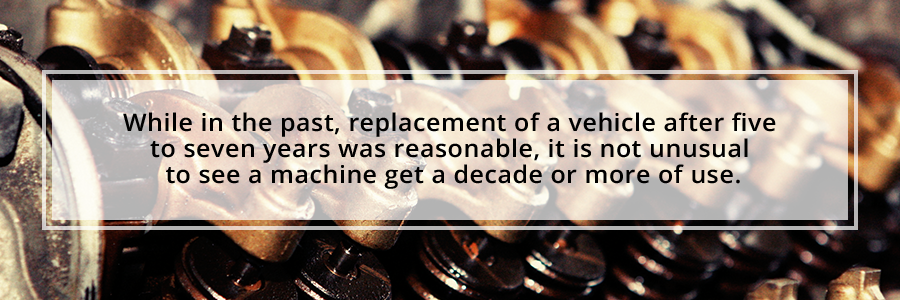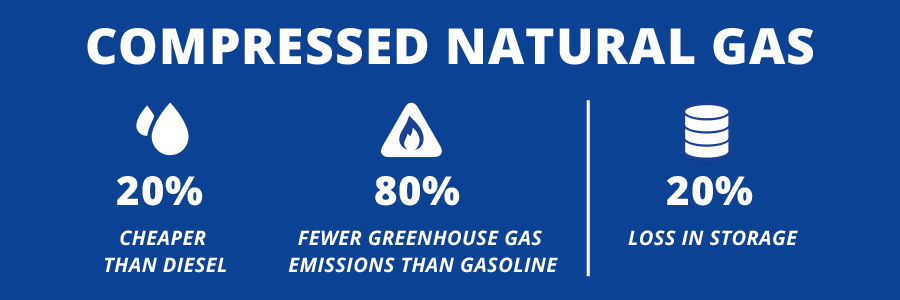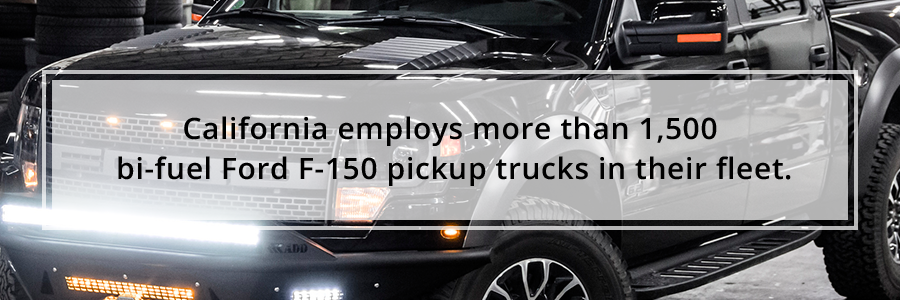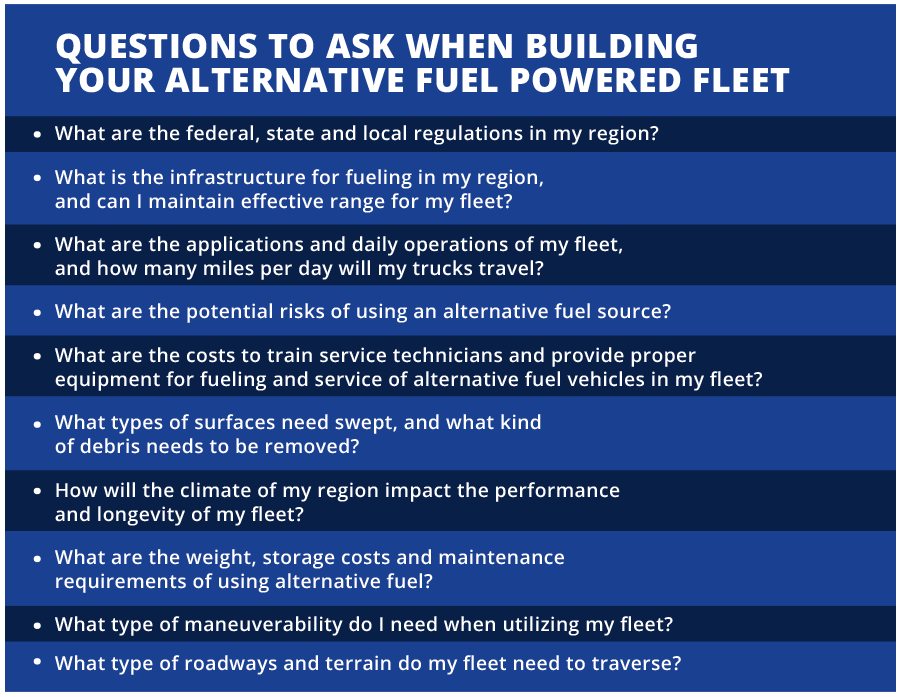Street Sweeper Trends and the Rise of Alternative Fuel Sweepers

Stricter state and federal emission standards, advances in technology, and an increased need for roadway versatility are changing the way governments and private companies build their fleets of street sweeper trucks across America.
The rapid change in consumer demand has prompted manufacturers to respond with more options than ever before for managers looking to purchase long-lasting, versatile, fuel-efficient, and environmentally safe fleets to clean the country's streets.
Street sweepers are costly and invaluable assets to urban and rural municipalities that need their vehicles to withstand years of wear and tear and harsh weather conditions in order to maintain roadway safety. In the past, diesel fuel was the primary source used to power the high horsepower engines of large industrial street sweepers, but the industry is slowly changing to alternate fuel street sweepers.
The shift from Diesel Powered Sweepers to Alternative Fuel Powered Street Sweepers
As state and federal emissions standards become more stringent, governments and private companies have gradually been switching from diesel-powered vehicles to more environmentally safe alternatives.
Southern California's South Coast Air Quality Management District was the first U.S. agency to ratify standards for debris and dust emissions in street sweepers. In 2000, the agency implemented a new regulation for fuel emissions in its jurisdiction, which required government and private street sweepers to obtain vehicles powered by alternative fuel sources.
Since then, many states have followed the SCAQMD's standards, and the Environmental Protection Agency is beginning to crack down as well.
Across the U.S., fleet managers needing to remain compliant with these new emission regulations and those in areas who see the changes coming have started to switch to alternative fuel vehicles or have begun to retrofit existing engines on older machines.
Alternative fuels commonly used in lieu of diesel include compressed natural gas (CNG), liquefied natural gas (LNG) and liquefied petroleum gas (LPG). As the demand for alternative fuels has grown, so has the natural gas industry.
While the expense of purchasing a new fleet or retrofitting a current one could be a daunting task for smaller, private street sweepers, the benefits of alternative fuel street sweepers have not only provided cleaner, more environmentally safe emissions that fall in line with changing EPA regulations, but they are also reducing the cost of powering these essential machines.
Demand for Increased Versatility and Advances in Technology
Emission regulations are not the only driving force behind the shift in buying trends for those seeking a more efficient fleet. The increased need for versatility and longevity is also prompting manufacturers to offer a new range of choices on vehicles.
Street sweepers need to pick up everything from dirt to large debris while traversing steep hills and varied terrain along America's roadways. Instead of purchasing multiple types of vehicles for separate tasks, limited budgets are prompting managers to buy fleets that can handle almost anything required.
In addition, weather conditions and climate are a large factor to consider when purchasing a fleet. Water is a useful resource when combating dust and debris, but for fleets operating in colder climates, frozen water tanks can be a major problem. Waterless sweepers are now available, and they offer the option of operation year-round regardless of the weather conditions along with the reduced potential for pollution.
Routine maintenance on existing vehicles is also an essential step in increasing the longevity of your fleet and saving money over the course of years. As municipal purse strings are pulled ever tighter, many are opting to repair rather than replace their street sweepers.

While in the past, replacement of a vehicle after five to seven years was reasonable, it is not unusual to see a machine get a decade or more of use. In order to keep pace with the trend, manufacturers are engineering vehicles that are easier to maintain.
Street Sweeper Technology
There are two main types of street sweepers available, and each offers its own advantage for different applications.
Mechanical Broom Sweepers
The most common type of street sweeper found in the United States is the mechanical broom sweeper. These vehicles use less fuel than any other type and provide enough maneuverability to operate safely in urban areas. When tough road conditions and large areas of debris need to be taken care of, mechanical broom sweepers offer a solution for removing anything from dust to heavy objects.
Air Vacuum Sweepers
Air vacuum sweepers come in two main varieties - regenerative air vacuum and pure vacuum sweepers. Both street sweeper types lift debris into a hopper with air, but there are differences in the technologies used.
Regenerative Air Sweepers
A more environmentally friendly and less expensive vehicle is a regenerative air sweeper. By utilizing a closed air loop stream, there is virtually no venting or exhaust. Regenerative air sweepers are also very effective for removing most kinds of street debris and are commonly seen operating in parking lots, roadways and other public areas.
Pure Vacuum Sweepers
Pure vacuum sweepers are the most efficient systems available, able to remove almost all material directly below the suction nozzles. However, these sweepers are the least popular in the U.S. The mechanics behind the system are similar to a vacuum cleaner and provide more versatility when cleaning gutter areas. These systems also utilize water and operate well on rougher roadways.
The Benefits of Buying CNG Sweepers
Compressed natural gas, which is mainly comprised of methane, has become increasingly common throughout the United States as a fuel source for industrial vehicles over the past 10 years.
The use of CNG fuel in street sweepers has steadily increased over the years, especially in Southern California. Vehicles powered by CNG offer a variety of benefits compared to traditional diesel fuel without decreasing efficiency and performance.
With plenty of government incentives available and a cost that's about 20 percent cheaper than diesel, CNG continues to grow in popularity around the country.
Because of this, the abundance of quick-filling, high-pressure fueling stations for CNG makes the resource more readily available to fleets in certain areas than liquefied natural gas, which lacks the same type of infrastructure.
Unlike liquefied natural gas, CNG is lighter than air and will dissipate if there is a leak, making it a much safer alternative to other fossil fuels. It also does not need to be cryogenically stored like LNG, which provides governments and private contractors with a better value.
While CNG still produces some emissions, it remains one of the cleanest fossil fuels available and produces 80 percent fewer greenhouse gas emissions than gasoline.
A downside to CNG is that the infrastructure needed for stations requires them to be located near a major pipeline, which has concentrated most stations in California, New York, Utah, Oklahoma, Arizona, Texas, and Colorado.

Another concern when choosing CNG is that heat is generated during quick fueling, which can cause more than a 20 percent loss in storage as the gas cools. Pressurization systems are needed to store CNG, which makes them more expensive than LNG systems.
Tanks to store CNG are also more expensive and cost approximately $12,000-$15,000 to replace.
The Benefits of Buying LNG Sweepers
Even though fueling stations for liquefied natural gas street sweepers are not as common as CNG stations in certain parts of the county, LNG can be transported over long distances, unlike CNG, in addition to providing other numerous benefits.
For fleets that need to continuously operate over long distances, LNG is a better alternative. Because there are many weight and space restrictions with CNG systems, LNG is becoming the choice for many.
LNG requires less than half the space that CNG does, but needs to be stored at minus 184 to minus 260 degrees Fahrenheit or fuel will be lost. Liquefied natural gas also offers a density similar to gasoline and diesel fuels, which prolongs a vehicle's range and requires less fueling time.
Unlike compressed natural gas, specialized training and equipment is needed for fueling when using LNG. It is odorless, and methane detectors should be used in LNG service areas.
In addition, LNG has two different types, saturated and unsaturated, which are color-coded by the industry to differentiate them. While all LNG must be stored cold and expands the warmer it gets, “cold LNG” is unsaturated, and “warm LNG” is saturated.
The reason for the differences is that all liquefied natural gas is transported in a cold, unsaturated state, but in order to be used by spark-ignited engines, it needs to be warmed. Cold LNG compression systems can increase a vehicle's range by up to 20 percent and decrease venting, which will lose fuel. Over time, LNG will eventually warm, and any venting must be considered when making your decision of which type of alternative fuel vehicle you should add to your fleet.
Many fleets that are operating on a consistent or daily basis can prevent this by utilizing their LNG supply within five days. Like CNG, it is one of the cleanest alternatives to petroleum-based fuel.
The Benefits of Buying LPG Sweepers
Another type of alternative fuel that is seeing an increased usage over diesel is liquefied petroleum gas or Autogas. LPG is a combination of propane, propylene, butane, and butylene, which is liquefied and needs to be pressurized to store.
It remains a cheaper and more environmentally safe alternative to diesel and gasoline but is more expensive than CNG. LPG is produced as a byproduct during the refining of petroleum. In addition, LPG can be transported across great distances, unlike CNG, and offers a better range to fleets operating for longer periods of time.
With more than twice the amount of energy released than natural gas, LPG is one of the most cost-effective fuel sources when switching your fleet to alternative fuel vehicles. LPG vehicles also require less maintenance than CNG-powered ones, increasing the longevity of your fleet.

At the moment, there are already a number of vehicles around the world that utilize LPG. From light- to heavy-duty vehicles, LPG is being used to fuel pickup trucks and forklifts. At the moment, California employs more than 1,500 bi-fuel Ford F-150 pickup trucks in their fleet.
One disadvantage of LPG is that performance varies depending on composition and can lead to cold starting. LPG also needs to be stored in specialized tanks and is heavier than air. It can settle in low-lying spots in garages and basements, creating the risk of explosions. Because of this risk, LPG vehicles have been banned from many indoor parking areas.
Cost-Effectiveness and Environmental Benefits
Staying in compliance with state, federal, and local emissions standards is becoming increasingly important for government and private fleets across America. But the shift from diesel fuel to alternative sources has not been easy, as the infrastructure to support and fuel AFVs is not readily available in many areas of the country.
By switching to an alternative fuel street sweeper, you will keep your fleet in compliance with new emission regulations and reduce your fuel costs in general, while providing better efficiency in your daily operations.
Because CNG, LNG, and LPG are all fuel sources that cost less than gasoline and diesel, you will save yourself money over time, but the upfront expense of purchasing a new fleet or retrofitting an existing one is an expensive undertaking.
This transition can prove challenging for many municipalities or private contractors who have limited budgets. To optimize your long-term savings, you should not only consider the available infrastructure in your area, but also the type of engine system required, the type of fuel you'll be using and how the fuel is stored. The ease of fueling, the demands of your fleet, and the advantages and disadvantages of the alternative fuel source should also be considered before making a purchase.
With the increased popularity and lower cost of natural gas, new infrastructure to support these systems is being set in place each year. Many of the problems facing the transition from diesel to alternative fuels are being solved by experts in government and manufacturers who are providing better options and services to consumers across the country.

Questions to Ask When Building Your Alternative Fuel Powered Fleet
- What are the federal, state, and local regulations in my region?
- What is the infrastructure for fueling in my region, and can I maintain an effective range for my fleet?
- What are the applications and daily operations of my fleet, and how many miles per day will my trucks travel?
- What are the potential risks of using an alternative fuel source?
- What are the costs to train service technicians and provide proper equipment for fueling and service of alternative fuel vehicles in my fleet?
- What types of surfaces need to be swept, and what kind of debris needs to be removed?
- How will the climate of my region impact the performance and longevity of my fleet?
- What are the weight, storage costs, and maintenance requirements of using alternative fuel?
- What type of maneuverability do I need when utilizing my fleet?
- What type of roadways and terrain does my fleet need to traverse?
If you want to save money on fuel expenses and build a more environmentally safe and efficient fleet, check out the fueling options you have available in your region, and consider purchasing street sweepers from Truck Site. Alternative fuel street sweepers will keep your fleet on the road for years to come.
Back To List